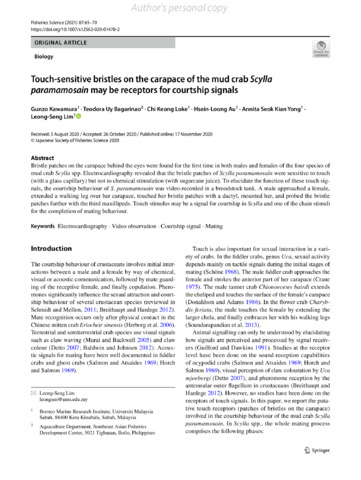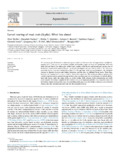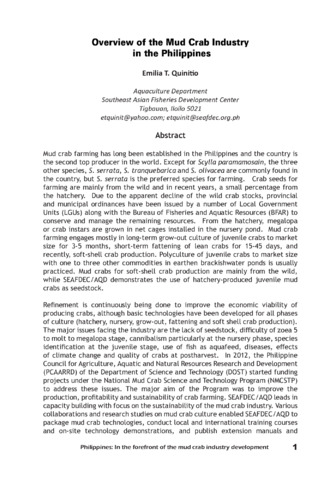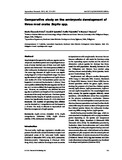Touch-sensitive bristles on the carapace of the mud crab Scylla paramamosain may be receptors for courtship signals

View/
Request this document
Date
2020-11-17Author
Page views
432Metadata
Show full item recordCited times in Scopus
Share
Abstract
Bristle patches on the carapace behind the eyes were found for the first time in both males and females of the four species of mud crab Scylla spp. Electrocardiography revealed that the bristle patches of Scylla paramamosain were sensitive to touch (with a glass capillary) but not to chemical stimulation (with sugarcane juice). To elucidate the function of these touch signals, the courtship behaviour of S. paramamosain was video-recorded in a broodstock tank. A male approached a female, extended a walking leg over her carapace, touched her bristle patches with a dactyl, mounted her, and probed the bristle patches further with the third maxillipeds. Touch stimulus may be a signal for courtship in Scylla and one of the chain stimuli for the completion of mating behaviour.
Suggested Citation
Kawamura, G., Bagarinao, T., Loke, C. K., Au, H.-L., Yong, A. S. K., & Lim, L.-S. (2020). Touch-sensitive bristles on the carapace of the mud crab Scylla paramamosain may be receptors for courtship signals. Fisheries Science , 87(1), 65-70. https://doi.org/10.1007/s12562-020-01478-2
Subject
Collections
- AQD Journal Articles [1215]
Related items
Showing items related by title, author, creator and subject.
-
Larval rearing of mud crab (Scylla): What lies ahead
Waiho, Khor; Fazhan, Hanafiah; Quinitio, Emilia T.; Baylon, Juliana C.; Fujaya, Yushinta; Azmie, Ghazali; Wu, Qingyang; Shi, Xi; Ikhwanuddin, Mhd; Ma, Hongyu (Elsevier, 2018)The increasing global demand for mud crabs (genus Scylla) and threats to the wild populations highlight the urgency of fully rearing them in captivity. Despite considerable progress in mud crab production, most crab farms ... -
Overview of the mud crab industry in the Philippines
Quinitio, Emilia T. (Aquaculture Department, Southeast Asian Fisheries Development Center, 2017)Mud crab farming has long been established in the Philippines and the country is the second top producer in the world. Except for Scylla paramamosain, the three other species, S. serrata, S. tranquebarica and S. olivacea ... -
Comparative study on the embryonic development of three mud crabs Scylla spp.
Ates, Maria Charmela D.; Quinitio, Gerald F.; Quinitio, Emilia T.; Sanares, Roman C. (Blackwell Publishing, 2012)Morphological changes in the embryos, egg size and development, incubation period and morphological structures of newly hatched zoea of three mud crab Scylla species were determined. The three species exhibited similar ...




